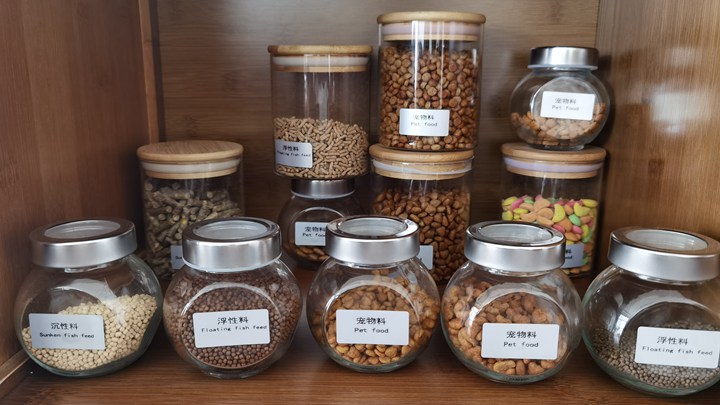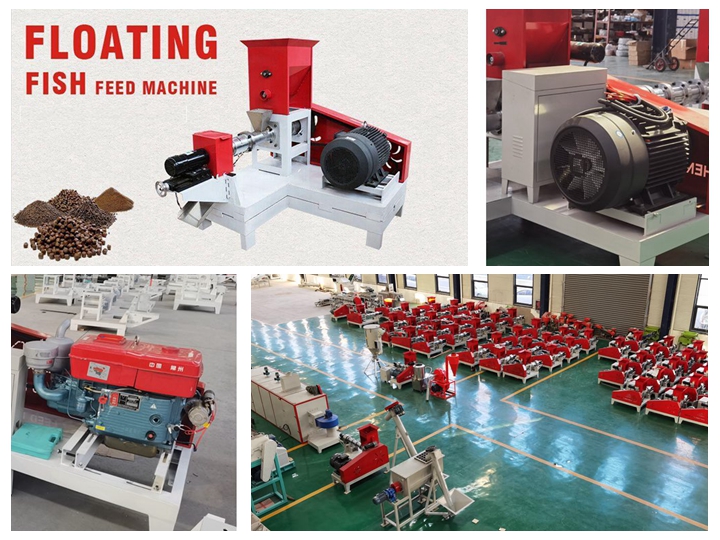.jpg)
Within the spectrum of floating fish feed production lines, the 150 kg/h fish feed mill plant stands out as a smaller output option. Despite its size, this fish food pellet production line excels in continuous operation, showcasing high production efficiency.
.jpg)
Floating fish feed making machine is a combination of screw and machine boring. When the material is conveyed to the extrusion cavity by extrusion, the material is subjected to mixing, stirring, friction and shearing forces to form a hydrothermal conditioning environment and play a role in sterilization, promote the comprehensive effects of starch gelatinization, crude fiber degradation, etc.
.jpg)
The fish feed extruder can produce various kinds of fish feeds, such as floating fish feed, sinking fish feed, slow sinking fish feed, and semi-moist fish feed. The relative density is less than 1. The relative density is less than 1.
.jpg)
Professional Turnkey CE Automatic Floating Fish Feed Mill Plant Professional Turnkey CE Automatic Floating Fish Feed Mill Plant,US $ 15000 ... easy operation, stable performance, easy maintenance and wide range of...
.jpg)
Highly Rated Floating Fish Feed Pellet Plant - Pellet Mill Plans for Start with our small fish feed pellet plant, we supply professional guidance and ... The process of the complete fish feed production line 1. ... feed mixing machine.
.jpg)
In this comprehensive guide, we’ll delve into the intricate process of constructing a state-of-the-art floating fish feed mill with a production capacity ranging from 1 to 5 tons per hour.
.jpg)
The floating fish feed extruder cooks the feed mixture under pressure, transforming it into pellets. before making fish feed, you need a grinder mill machine to crush raw materials. Pelletizers : If your plant will produce mash or crumbled feed, a pelletizer will be necessary to form the feed into small, uniform sizes.

The table provides cost data for illustrative purposes and you should not consider them as definitive or current market rates. These approximate values aim to give you a general idea of the setup costs for fish feed mill plants across different countries.Actual costs can vary widely depending on a range of factors including the specific location within the country, the current economic climate
.jpg)
We can provide customers with a one-stop, complete set of professional floating fish feed production solutions to solve the problems of customers, especially pure investment customers, such as technical difficulties and lack of understanding of equipment, which makes the needs and positioning of the project clearer, and also makes the customer’s fish feed equipment selection range is more
.jpg)
Before designing, it is possible to investigate the running fish feed mill plant, and listen carefully to the user’s feedback, problems and opinions existing in the operation of the floating fish feed plant, improve the design scheme, and ensure the use of functions. 01 20-24T/H fish feed mill plant cost
.jpg)
The main cattle fish feed mill machine includes 37kw feed grinding machine, 500kg/batch feed mixer equipment, 90kw floating fish feed extruder, cattle feed extruder, feed dying machine, SKLN11*11 pellet cooler, vibrating shifter, etc. The entire feed mill plant of this project is simple to set up and has an orderly production.
.jpg)
This floating fish feed extruder machine, also called floating fish feed pellet mill, is mainly utilized for making floating fish feed pellets or sinking, slow sinking fish feed for catfish, aquarium fish, shrimp, tilapia, red or black porgy, rainbow trout, carp; it can also be pet food extruder for making pet food for dog and cat.
.jpg)
There are mainly 3 types of fish feed: Floating Fish Feed; Sinking Fish Feed; Slow Sinking Fish Feed/Fish Bait; To make different fish feed pellets, the production process, required equipment and investing cost are different!
.jpg)
Introduction. Understanding the fish feed extrusion process is crucial for anyone in the aquaculture industry. Whether you’re a manufacturer, supplier, or a fish farm owner, knowing how extrusion works can significantly impact your operations.

1. Requirements of aquafeed. 1) Grinding fineness: Proper particle size of ground materials can contribute to lower energy consumption of a feed mill, facilitate the subsequent conditioning process, increase the water stability of aquafeed pellets, and eventually obtain nutritional aquafeed that benefits the digestibility of aquatic animals.